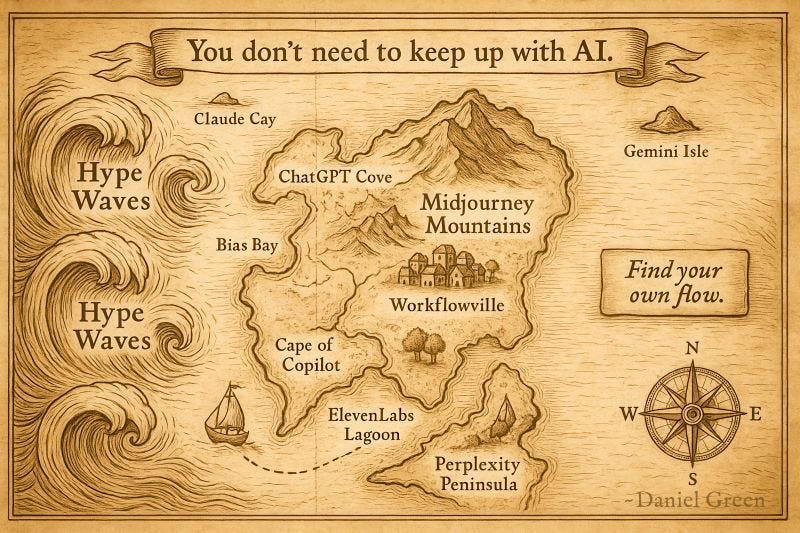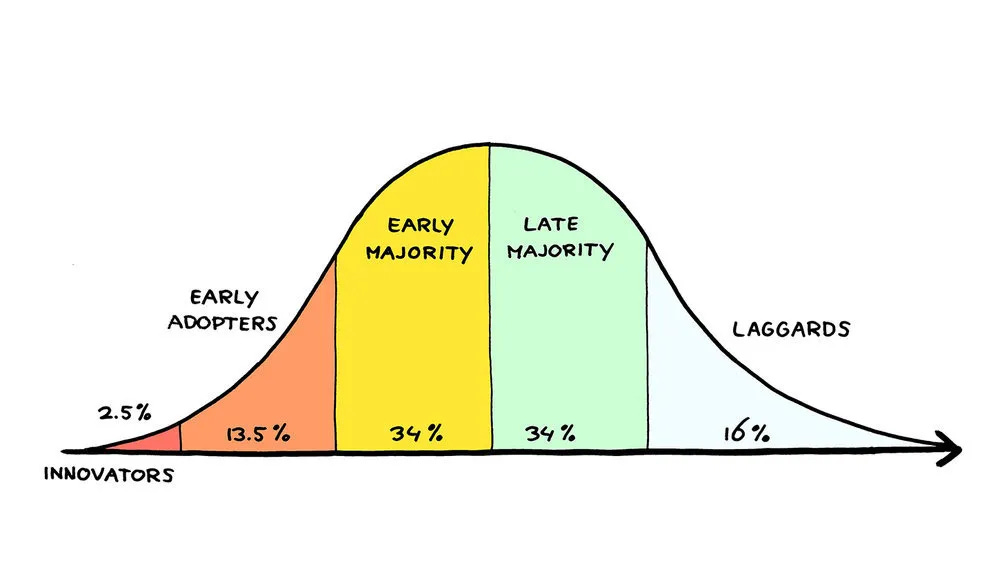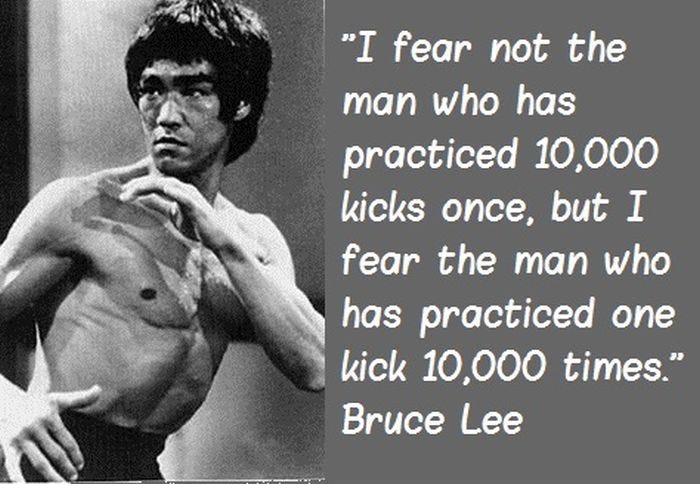You Don't Need to Keep Up With AI (Collab Post With Daniel Green)
A practical guide to thriving with AI
My friend Daniel Green is one of the biggest AI experts I know. While I consider myself an early adopter of new technologies, usually trying them within the first few weeks of their release, Daniel is the kind of guy who will try them within minutes of their release. Often, by the time I have tested these tools, he has already mastered them, gotten bored, and is on to the next new thing. It is common for us to discuss AI and for me to leave with 20+ new insights and ideas.
In this article, I would like to share, with his permission, a LinkedIn post he wrote titled, “You don’t need to keep up with AI.” The original post can be found here. It is an insightful analysis covering six levels of AI mastery. It points out that everyone doesn’t need to aspire to level six mastery. After sharing Daniel’s post, I share a few thoughts of my own, covering my agreements and disagreements. Anyone not interested in reading the full article can find a summary here.
You don’t need to keep up with AI (Daniel’s post)
Centuries ago explorers like Magellan, Columbus, and James Cook expanded our world maps; later, Shackleton braved the Antarctic ice. Their courage and curiosity changed the world. A similar pattern unfolds today with AI. A small set of developers, dreamers, and daredevils test raw models, log bugs, & push the limits of new tools so the rest of us can work with AI safely and productively.
Most professionals do not need to live on that frontier. We all already collaborate with AI every day, often without noticing. I call these working relationships #pairtnerships: partnerships with AI where we share tasks and compound results.
The Pairtnership Spectrum
Level 1: Passive Collaborators
AI works quietly in the background. Gmail finishes sentences, Spotify builds playlists, photo apps tag friends. You invest zero effort and enjoy seamless convenience.
Level 2: Active Collaborators
You occasionally ask, "How might AI help me with this?" AI isn't your starting point but rather an afterthought. You use OpenAI #ChatGPT for emails, Canva for quick designs, or Grammarly to polish text. AI steps in as a helpful assistant when prompted.
Level 3: Work Colleagues
You are comfortable with prompting and have AI‑augmented daily processes. AI drafts reports, cleans data, and handles follow‑ups, saving hours each week and raising quality. You experiment with advanced features like voice modes, but only where they add clear value.
Level 4: T‑Shaped Teammates
You're deeply skilled in one core AI tool, often using 80% or more of its capabilities, frequently ChatGPT. You regularly interact with advanced AI features like voice modes, seamlessly blending them into your workflows. Coworkers see you as the "office AI guru." A marketer optimizes campaigns with Anthropic #Claude, a lawyer sharpens clauses with Copilot, and AI enhances, rather than replaces, your specialized expertise.
Level 5: Boundary Pushers
You lead with an "AI‑first" mindset and wield #superpowers across dozens of tools like Gumloop, Granola, Midjourney, ElevenLabs, Lovable, Hedra, Napkin AI and Perplexity. You find new features, stack workflows, and push the edges of knowledge work, sharing discoveries even though you may not write code.
Level 6: Frontier Explorers ("AI Experts")
The small group of developers, dreamers, and daredevils explore new models & methods on Hugging Face & GitHub. Their pioneering work establishes best practices that trickle down to other levels.
Moving across these levels isn't about speed or trying everything at once. Instead, focus first on becoming highly skilled with one AI instrument, much like mastering one musical instrument before picking up another. Choose an AI instrument, learn its nuances, & deepen the #pairtnership.
What level are you currently on? How might leveling up transform your work or daily life?
#ArtificialIntelligence #AI #Collaboration #FutureOfWork #DigitalTransformation #CareerGrowth
My points of agreement
I agree with many parts of Daniel’s post, specifically:
1). I agree with the different levels used to conceptualize one’s level of AI expertise.
2). I agree that individuals will naturally gravitate towards and fall into specific levels of AI expertise based on their appetite for innovation and technical knowledge. This aligns with the “Technology Adoption Life Cycle” expressed by Geoffrey A Moore in his classic book, “Crossing the Chasm”.
#3 - I agree that starting with one AI tool and becoming highly skilled before moving on to new tools is a good approach to level up your expertise and get the most out of AI. As Bruce Lee said, “I fear not the man who has practiced 10,000 kicks once, but the man who has practiced one kick 10,000 times”.
My points of disagreement
I would not say that I disagree majorly with anything Daniel said. However, I think that saying, “You don’t need to keep up with AI,” is too simplistic and could lead people to draw the wrong conclusions. Instead, I believe that you should do your best to assess how AI is likely to transform the workplace and then determine how you can thrive in this new reality, given your unique strengths and aptitudes.
I believe that there will be five different types of roles in future workplaces:
1). AI Innovators - These individuals are on the cutting edge of AI, identifying brilliant and novel use cases and pitching them across teams. They usually have deep technical expertise, creativity, and the ability to sell their ideas to key decision-makers. Head of Research and Development and Head of Innovation are existing roles that fit naturally as “AI Innovators.”
2). AI Systems Builders - These individuals take the innovator’s ideas and build powerful and cost-effective systems to put them into action. They are usually tech-savvy, logical, systems-driven, business-savvy, good at juggling constraints, and good at bridging the gap between the interpersonal and technical sides of AI. Head of Ops, Sales Ops, and Biz Ops are existing roles that fit naturally as “AI Systems Builders.”
3). AI Implementors - These individuals take the systems builder’s plans and systems and get them adopted across teams. They then maintain and oversee the systems once they are implemented. They are usually reliable, consistent, exacting, good teachers, and fantastic at delivering results in a timely manner. Traditional people managers and project managers are existing roles that fit naturally as “AI Implementors.”
4). Creatives - These individuals are great at generating fresh and novel ideas and assessing AI output to determine its quality and whether it will resonate emotionally with humans. They possess deep knowledge or expertise in a niche, as well as great taste. they are usually artistic, hip, discerning in their tastes, and self-assured. Product Managers, Designers, or Content Specialists are existing roles that fit naturally as “Creatives.”
5). Sellers / Relationship Builders - These individuals are great at persuasion and relationship building. They are masters at establishing trust with people and convincing them to take action. They are usually outgoing, love organizing events, and frequently connect people within their networks. Sales, Biz Dev, and Partnerships are all existing functions that fit naturally as “Sellers or Relationship Builders.”
I would argue that roles one and two are the level 5 and level 6 AI experts (as defined by Daniel) who need to stay close to the cutting edge of AI and empower the rest of the team with these skills and capabilities. If you are not interested or inclined to play on that level, it is essential to determine your strengths and aptitudes to determine whether you are best suited to offer value as an “AI Implementor,” “Creative,” or “Seller / Relationship Builder.”
Why can’t AI just do everything?
While some experts believe that we’re on the verge of creating an artificial general intelligence (AGI) that will make humans in the workplace essentially obsolete, I think humans will have some roles to play for a while. While the “AI Innovators” and “AI Systems Builders” play an instrumental role in replacing existing workflows with AI automation, AI has several blindspots and shortcomings that these other roles help to support:
1). AI can’t oversee people management and coordination: As long as companies employ humans, there are bound to be personnel issues. People get sick, and backup is required; internal fights and disagreements occur; some individuals slack off and skip assigned tasks, etc. Furthermore, people at the company expect regular updates on their performance versus goals and whether they are on track for career advancement. An “AI Implementor” who can also manage people and ensure the smooth functioning of teams is critical.
2). AI often hallucinates or lacks refined taste: Whether producing content, writing code, or generating images, AI frequently misses the mark. Sometimes, this is because AI hallucinates and ends up producing gibberish. Other times, it is because AI relies heavily on its training data and spits back output, which is the net average of that data.
These hallucinations or generic outputs are frequently overlooked by individuals who lack taste or discernment in a particular niche. Speaking from my experience as a decent but not great programmer, I have implemented AI code that a savvy engineer would have instantly recognized as junk. In many other cases, astute designers or copywriters could use AI selectively to augment their capabilities while using their taste to throw out the junk output. Without the “Creatives,” this junk slips through the cracks, and there is no barometer for what constitutes quality.
3). Humans buy from other humans: Even with the rise of sales automation tools and robot callers, people still ultimately want to buy from other humans, especially as the price tag rises. Your 12-step automated email flow with AI customization won’t close Jim, the Fortune 500 CFO, who buys from Rick on your team because “We’re drinking buddies and love to play golf and talk shit.” In many deals, AI might get you 80% of the way there, but a human is still required to push things over the line.
Conclusion
Daniel’s message is both refreshing and liberating: you don’t need to keep up with every twist and turn in the AI landscape to be successful. In fact, for most people, obsessing over the cutting-edge can be more distracting than productive.
But here’s where I’d take it a step further: forget keeping up with AI - focus on leveling up yourself: your growth, your edge, and your place in a world that’s changing at lightning speed. The real question isn’t “Am I at level 6?” - it’s “How can I go deeper at the level I’m best suited for?”
If you liked this content, please click the <3 button on Substack so I know which content to double down on.
TLDR Summary
You don’t need to keep up with every new AI tool or breakthrough to succeed. Instead, identify your strengths, master the AI tools that align with them, and find your role in an AI-driven workplace. Focus on deepening your impact, not chasing trends.
Key Points and Insights
The AI Pairtnership Spectrum (Daniel Green’s Framework):
Passive Collaborators – AI helps in the background with zero effort.
Active Collaborators – Use AI occasionally as an assistant.
Work Colleagues – Regular AI use to enhance productivity.
T-Shaped Teammates – Deep expertise in one AI tool integrated into workflows.
Boundary Pushers – AI-first thinkers using multiple tools creatively.
Frontier Explorers – Pioneers developing and experimenting with cutting-edge AI models.
You don’t need to aim for Level 6
Most people will find value by mastering a single tool and integrating it into their role, rather than chasing the newest AI trends.Role-Based Approach to AI in the Workplace:
AI Innovators – Visionaries exploring novel use cases.
AI Systems Builders – Build and implement technical solutions.
AI Implementors – Deploy and maintain systems across teams.
Creatives – Use judgment and taste to refine AI outputs.
Sellers / Relationship Builders – Use human connection to drive action.
Humans are still essential because:
AI can’t handle team dynamics or people management.
AI lacks taste and quality discernment.
Human relationships and trust still drive high-stakes business deals.
Conclusion
Daniel Green’s perspective is a refreshing reminder: most people don’t need to obsess over AI’s cutting edge to thrive. The smarter approach is to go deeper into the AI tools and workflows that align with your strengths. In a rapidly changing world, success lies not in “keeping up,” but in leveling up - on your own terms.










Great duo!! This was such a refreshing take—thank you both for cutting through the noise and reminding us that not keeping up can actually be a power move.